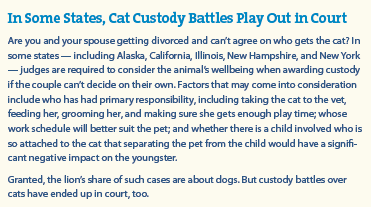Don’t kid yourself. If you and your partner haven’t been getting along, your cat knows it — and is experiencing the stress. It might not seem obvious because cats often don’t like to give away their feelings. Also, if you’re upset, you might be inclined to miss cues from your pet, or fail to connect those cues to the charged emotions in the house. Such cues could include your cat’s withdrawing more often than usual, missing the litterbox, licking herself more frequently, meowing more, eating less, or spray-
ing territorially.
In whatever ways your cat does or doesn’t respond to your arguing — or to the stony silences that have developed between you and your partner — it’s important for you to be aware that her sense of emotional security and comfort have been thrown off. It’s not just you who is suffering.
And if not getting along finally ends in a breakup, the emotional fallout for your pet will become greater still. Someone she is used to leaves, or maybe even both of you relocate.
Clothes and furniture are moved, too. The physical world to which she has become accustomed is pulled out from under her. How do you mitigate her anxiety?
Tips to ease breakup trauma for your cat
Consider the following if you and your partner separate.
The place might be more important than the person. It might seem that a cat should always go with the person to whom she is more bonded. But in some cases, a cat might be more attached to her surroundings than her favorite human. If a cat clearly prefers one partner to the other, then it might be best for her to be with that partner, even if it signifies a move. But if her bond with each of you is closer to 50/50, chances are high that she should remain where she is.
Try to stay courteous with each other before separating. It’s hard to keep it together all the time when you’re angry or hurt and when life is about to change dramatically. But to the extent that you and your partner can remain courteous before the split, the better it will be for your pet. She is there. She is listening. Just like you would try not to argue in front of the children, you should try to keep it civil in front of your feline. If you do feel the need to argue, “you can go for a walk or drive in order not to have the argument in front of your pet,” suggests the head of the Tufts Animal Behavior Clinic, Stephanie Borns-Weil, DVM.

Forget shared custody. Some dogs, as difficult as it might be, would prefer to spend half their time with one partner and half with the other. And some dog parents are able to work that out. Cats almost always do not want to be shunted back and forth between one home and the other. Expect that one of the two human partners is going to be cut out of the equation.
If the cat leaves with one of the partners rather than stays put, set up her new home appropriately. Bring the old scratching post with its familiar scents and fabric rips, the old litterbox, all her toys, her food bowl, and other accouterments. The more you can maintain what’s familiar to your pet, the happier she will be.




